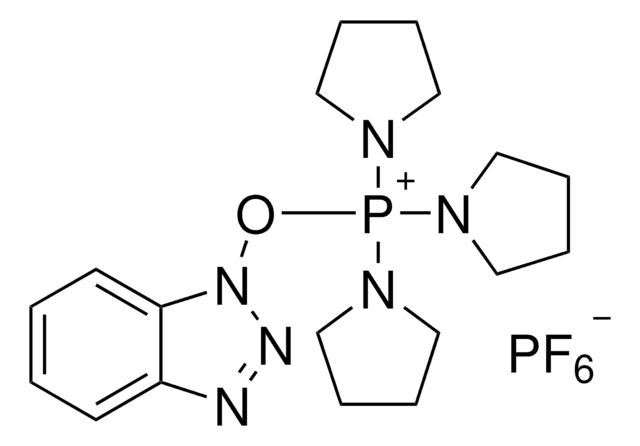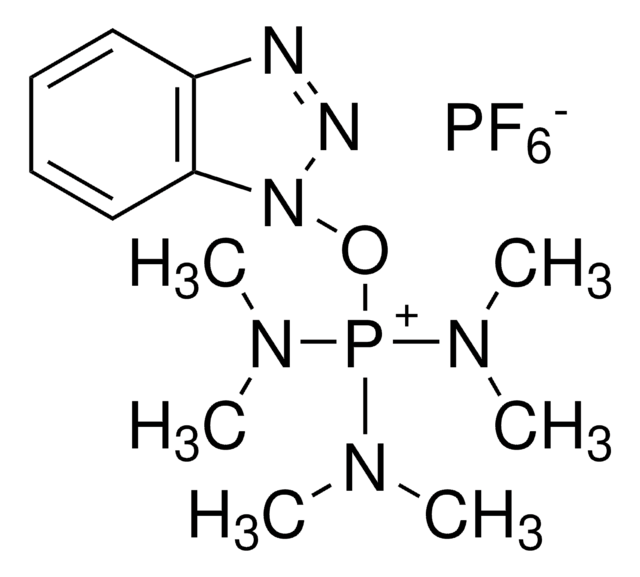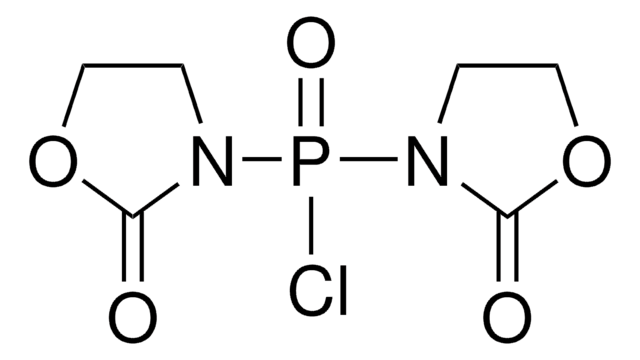535303
(7-Azabenzotriazol-1-yloxy)tripyrrolidinophosphonium hexafluorophosphate
96%, for peptide synthesis
Synonyme(s) :
(3-Hydroxy-3H-1,2,3-triazolo[4,5-b]pyridinato-O)tri-1-pyrrolidinyl-phosphorus hexafluorophosphate, PyAOP
About This Item
Produits recommandés
product name
(7-Azabenzotriazol-1-yloxy)tripyrrolidinophosphonium hexafluorophosphate, 96%
Pureté
96%
Capacité de réaction
reaction type: Coupling Reactions
Pf
163-168 °C (lit.)
Application(s)
peptide synthesis
Température de stockage
−20°C
Chaîne SMILES
F[P-](F)(F)(F)(F)F.C1CCN(C1)[P+](On2nnc3cccnc23)(N4CCCC4)N5CCCC5
InChI
1S/C17H27N7OP.F6P/c1-2-11-21(10-1)26(22-12-3-4-13-22,23-14-5-6-15-23)25-24-17-16(19-20-24)8-7-9-18-17;1-7(2,3,4,5)6/h7-9H,1-6,10-15H2;/q+1;-1
Clé InChI
CBZAHNDHLWAZQC-UHFFFAOYSA-N
Vous recherchez des produits similaires ? Visite Guide de comparaison des produits
Catégories apparentées
Application
Cyclic RGC pentapeptides for functionalization through click chemistry
Fluorescent glucose bioprobes
ReactIR™ flow cell
Reagent for:
Disulfide bond engineering
Heteroaryl ether synthesis
Optimization of conformational constraint on non-phosphorylated cyclic peptide antagonists of the Grb2-SH2 domain
Informations légales
Mention d'avertissement
Warning
Mentions de danger
Conseils de prudence
Classification des risques
Eye Irrit. 2 - Skin Irrit. 2 - STOT SE 3
Organes cibles
Respiratory system
Code de la classe de stockage
11 - Combustible Solids
Classe de danger pour l'eau (WGK)
WGK 3
Équipement de protection individuelle
dust mask type N95 (US), Eyeshields, Gloves
Certificats d'analyse (COA)
Recherchez un Certificats d'analyse (COA) en saisissant le numéro de lot du produit. Les numéros de lot figurent sur l'étiquette du produit après les mots "Lot" ou "Batch".
Déjà en possession de ce produit ?
Retrouvez la documentation relative aux produits que vous avez récemment achetés dans la Bibliothèque de documents.
Les clients ont également consulté
Notre équipe de scientifiques dispose d'une expérience dans tous les secteurs de la recherche, notamment en sciences de la vie, science des matériaux, synthèse chimique, chromatographie, analyse et dans de nombreux autres domaines..
Contacter notre Service technique














